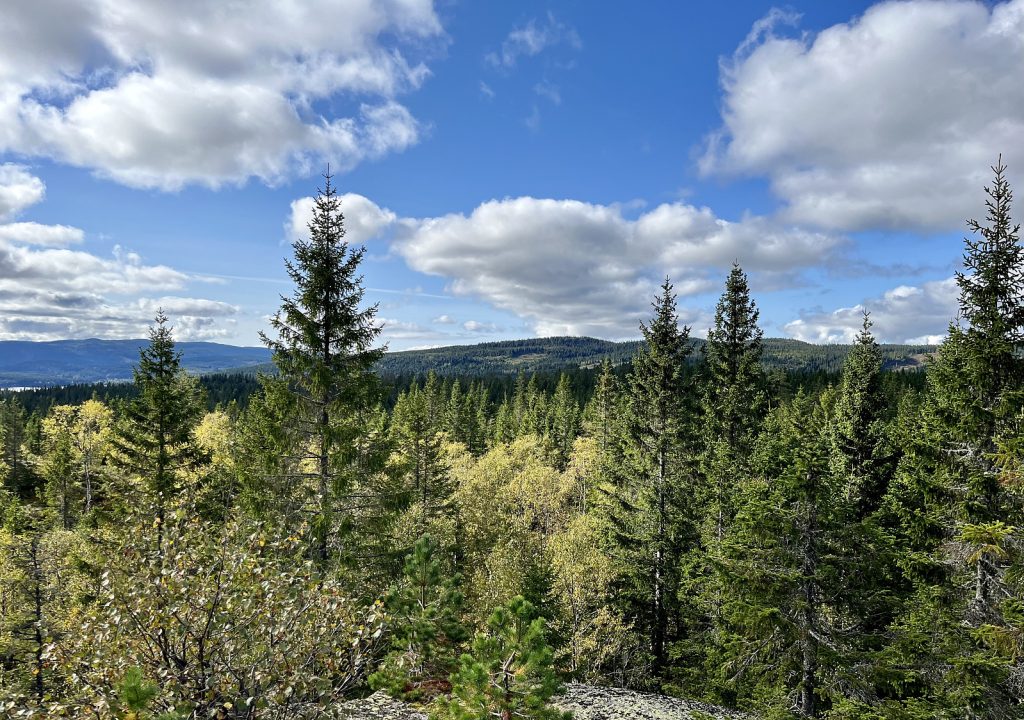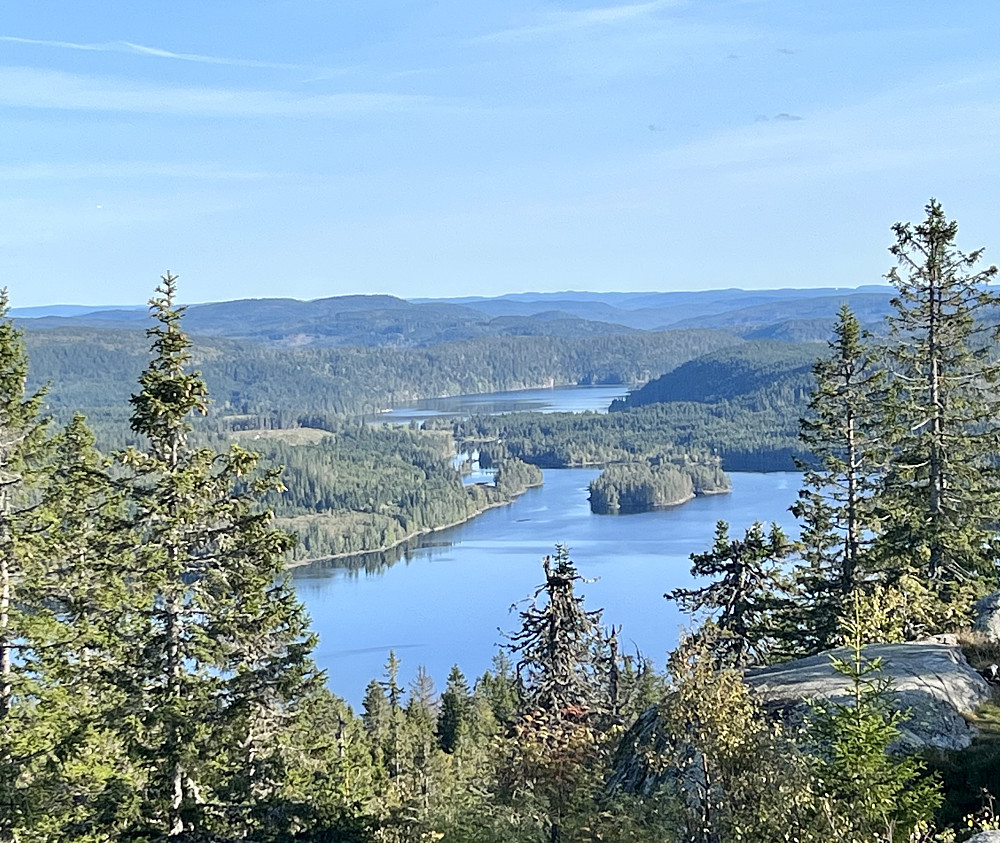

The highest spot in Oslo, Norway, is Kjerkeberget, reaching 631 meters (2,070 feet) above sea level. Located in the Nordmarka forest, north of Oslo’s urban center, Kjerkeberget offers panoramic views over Oslo, the fjord, and surrounding areas. As one of Oslo’s most scenic natural landmarks, it is popular among hikers and outdoor enthusiasts, especially for those interested in experiencing Norway’s beautiful landscapes without venturing far from the city.
Geographical Details
Kjerkeberget lies in Oslo’s extensive Nordmarka forest, a region renowned for its wilderness, dense pine and spruce forests, and a network of lakes. This forested area forms part of a larger network of nature reserves and forested lands extending across eastern Norway. While the summit of Kjerkeberget is relatively modest compared to Norway’s mountainous terrain, it is still a significant high point within the city limits and provides an accessible way to experience highland wilderness close to Oslo.
The area surrounding Kjerkeberget features numerous trails, making it a popular destination for hikers, cyclists, and cross-country skiers. The ascent is achievable within a day, with paths suitable for various skill levels. The terrain includes both rocky outcrops and wooded areas, adding to its scenic diversity. Visitors often encounter Norway’s unique wildlife, including moose, deer, and a wide range of bird species.
Historical Significance
Historically, Kjerkeberget and the Nordmarka area have been important resources for Oslo’s residents. The forest around Kjerkeberget has provided timber for construction and heating for centuries. Evidence of early human activity includes old trails and logging roads, some of which date back several hundred years. In addition to its practical uses, Nordmarka has a long-standing cultural significance, celebrated in Norwegian folklore and literature. Many Oslo residents, including Henrik Ibsen, found inspiration in these forests and often referenced them in their work.
During World War II, Nordmarka also played a part in Norway’s resistance efforts. The forest’s secluded areas and rugged terrain made it an ideal location for underground activities, and some landmarks within Nordmarka have connections to resistance operations against the German occupation.
Modern Access and Outdoor Culture
Today, Kjerkeberget remains a beloved destination for outdoor recreation. Norway’s deep-rooted outdoor culture, known as “friluftsliv” (the love of open-air living), encourages people to engage with nature regularly, and Oslo residents take full advantage of this. Public transportation and marked trails make it easy to reach Kjerkeberget, even for those without private vehicles. Winter sports, such as cross-country skiing, are especially popular, and the trails around Kjerkeberget are well-maintained in winter.
For those seeking to enjoy the natural beauty and peaceful solitude of Oslo’s highest point, Kjerkeberget offers both scenic views and a slice of history nestled in Norway’s pristine landscape. Whether for hiking, skiing, or simply appreciating the panoramic views over Oslo, it’s an ideal destination that captures Norway’s commitment to preserving nature and honoring its cultural heritage.
The highest spot in Oslo, Norway, is Kjerkeberget, reaching 631 meters (2,070 feet) above sea level. Located in the Nordmarka forest, north of Oslo’s urban center, Kjerkeberget offers panoramic views over Oslo, the fjord, and surrounding areas. As one of Oslo’s most scenic natural landmarks, it is popular among hikers and outdoor enthusiasts, especially for those interested in experiencing Norway’s beautiful landscapes without venturing far from the city.
Geographical Details
Kjerkeberget lies in Oslo’s extensive Nordmarka forest, a region renowned for its wilderness, dense pine and spruce forests, and a network of lakes. This forested area forms part of a larger network of nature reserves and forested lands extending across eastern Norway. While the summit of Kjerkeberget is relatively modest compared to Norway’s mountainous terrain, it is still a significant high point within the city limits and provides an accessible way to experience highland wilderness close to Oslo.
The area surrounding Kjerkeberget features numerous trails, making it a popular destination for hikers, cyclists, and cross-country skiers. The ascent is achievable within a day, with paths suitable for various skill levels. The terrain includes both rocky outcrops and wooded areas, adding to its scenic diversity. Visitors often encounter Norway’s unique wildlife, including moose, deer, and a wide range of bird species.
Historical Significance
Historically, Kjerkeberget and the Nordmarka area have been important resources for Oslo’s residents. The forest around Kjerkeberget has provided timber for construction and heating for centuries. Evidence of early human activity includes old trails and logging roads, some of which date back several hundred years. In addition to its practical uses, Nordmarka has a long-standing cultural significance, celebrated in Norwegian folklore and literature. Many Oslo residents, including Henrik Ibsen, found inspiration in these forests and often referenced them in their work.
During World War II, Nordmarka also played a part in Norway’s resistance efforts. The forest’s secluded areas and rugged terrain made it an ideal location for underground activities, and some landmarks within Nordmarka have connections to resistance operations against the German occupation.
Modern Access and Outdoor Culture
Today, Kjerkeberget remains a beloved destination for outdoor recreation. Norway’s deep-rooted outdoor culture, known as “friluftsliv” (the love of open-air living), encourages people to engage with nature regularly, and Oslo residents take full advantage of this. Public transportation and marked trails make it easy to reach Kjerkeberget, even for those without private vehicles. Winter sports, such as cross-country skiing, are especially popular, and the trails around Kjerkeberget are well-maintained in winter.
For those seeking to enjoy the natural beauty and peaceful solitude of Oslo’s highest point, Kjerkeberget offers both scenic views and a slice of history nestled in Norway’s pristine landscape. Whether for hiking, skiing, or simply appreciating the panoramic views over Oslo, it’s an ideal destination that captures Norway’s commitment to preserving nature and honoring its cultural heritage.


